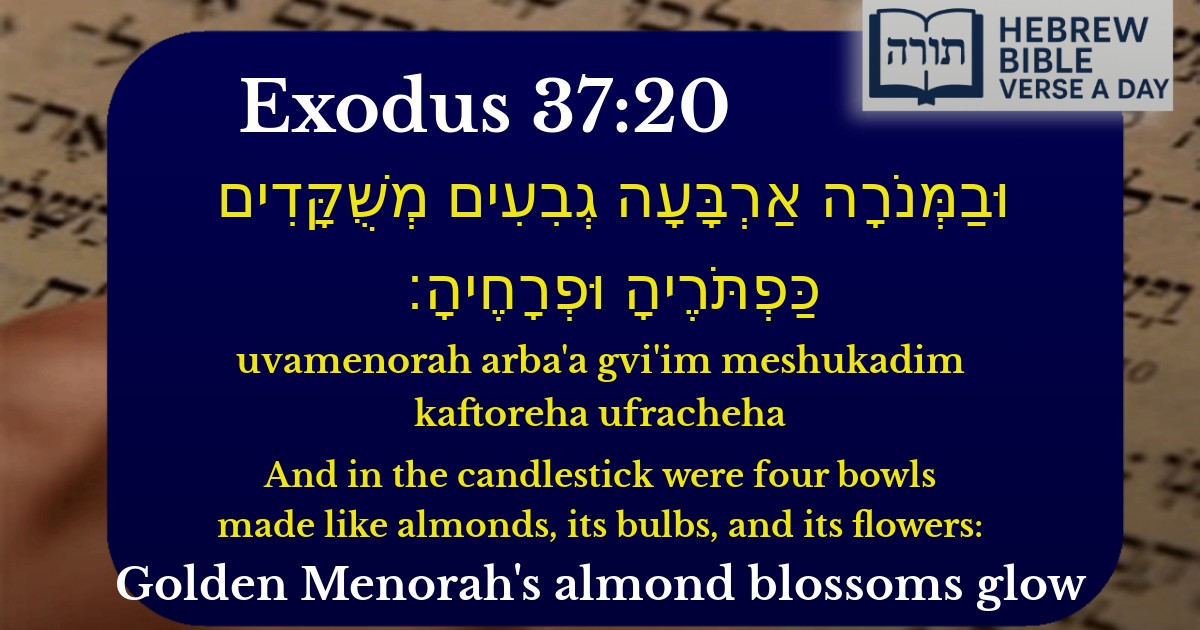Frequently Asked Questions
Q: What does Exodus 37:20 mean when describing the Menorah's design?
A: Exodus 37:20 describes the intricate details of the Menorah (candelabrum) in the Mishkan (Tabernacle). It mentions four 'cups' shaped like almond blossoms, along with its knobs (bulbs) and flowers. According to Rashi, these almond-shaped cups symbolize diligence and haste, as the almond tree blossoms quickly (based on Jeremiah 1:11-12). The Rambam explains that these details were part of the divine commandment to craft the Menorah exactly as instructed.
Q: Why are almond blossoms specifically mentioned in the Menorah's design?
A: Almond blossoms (שְׁקֵדִים) are mentioned because they symbolize divine watchfulness and swift fulfillment of Hashem's will. The Midrash (Bamidbar Rabbah 15:7) connects this to the almond branch in Aaron's staff that blossomed overnight (Numbers 17:23), showing G-d's approval. The almond tree is also the first to bloom in spring, representing zeal in serving Hashem.
Q: How many cups were on the Menorah according to Exodus 37:20?
A: The verse specifies that there were four cups (גְּבִעִים) on the Menorah, shaped like almond blossoms. However, the Talmud (Menachot 28b) clarifies that there were actually three cups on each of the six branches (totaling 18) and four cups on the central stem, making 22 cups in total. The four mentioned here refer specifically to the central stem's design.
Q: What is the significance of the Menorah's floral design?
A: The Menorah's bulbs, flowers, and almond-shaped cups (Exodus 37:20) teach that our spiritual light must be beautiful and purposeful. The Midrash (Shemot Rabbah 36:1) compares the Menorah to the Torah's wisdom, which 'illuminates' like a flame. The almond motif also reminds us to perform mitzvot with urgency, as the almond tree swiftly blossoms (Rashi on Jeremiah 1:11).
Q: Does the Menorah's design have practical lessons for today?
A: Yes! The Menorah's almond-blossom cups (Exodus 37:20) remind us to serve Hashem with beauty and diligence. Just as the almond tree is quick to bloom, we should be eager to perform mitzvot without delay (based on Rashi). The Talmud (Shabbat 22b) also derives from the Menorah that we must elevate our actions to a higher spiritual purpose, just as its light was directed upward.


Explanation of the Menorah's Design
The verse (Shemot 25:34) describes the intricate details of the Menorah in the Mishkan (Tabernacle), specifically mentioning its four גְבִעִים (bowls), כַּפְתֹּרֶיהָ (bulbs), and וּפְרָחֶיהָ (flowers). According to Rashi, the bowls were shaped like almond blossoms (מְשֻׁקָּדִים), resembling the cups used for wine libations. The Sforno adds that these almond-shaped bowls symbolized diligence, as the almond tree (שָׁקֵד) is the first to blossom in spring, representing Hashem's swift fulfillment of His word (see Yirmiyahu 1:11-12).
Symbolism of the Almond Motif
The Talmud (Menachot 28b) discusses the Menorah's construction, emphasizing that its design was Divinely instructed to Moshe in precise detail. The almond imagery reflects:
Structural Interpretation
Rambam (Hilchot Beit HaBechirah 3:10) notes that the Menorah's bulbs and flowers were not merely decorative but integral to its halachic validity. The כַּפְתֹּר (bulb) served as a node connecting the branches, while the פֶּרַח (flower) symbolized spiritual blossoming. The Malbim explains that the four bowls on each branch (totaling 28) allude to the 28 times King David mentioned "my soul" in Tehillim 119—underscoring the Menorah's role in illuminating the soul's connection to Hashem.
Kabbalistic Insight
The Zohar (Terumah 152a) associates the Menorah's almond blossoms with the sefirah of Yesod, representing purity and continuity. The four bowls correspond to the four letters of Hashem's Name (הוי"ה), channeling Divine light into the world through the Mishkan's service.